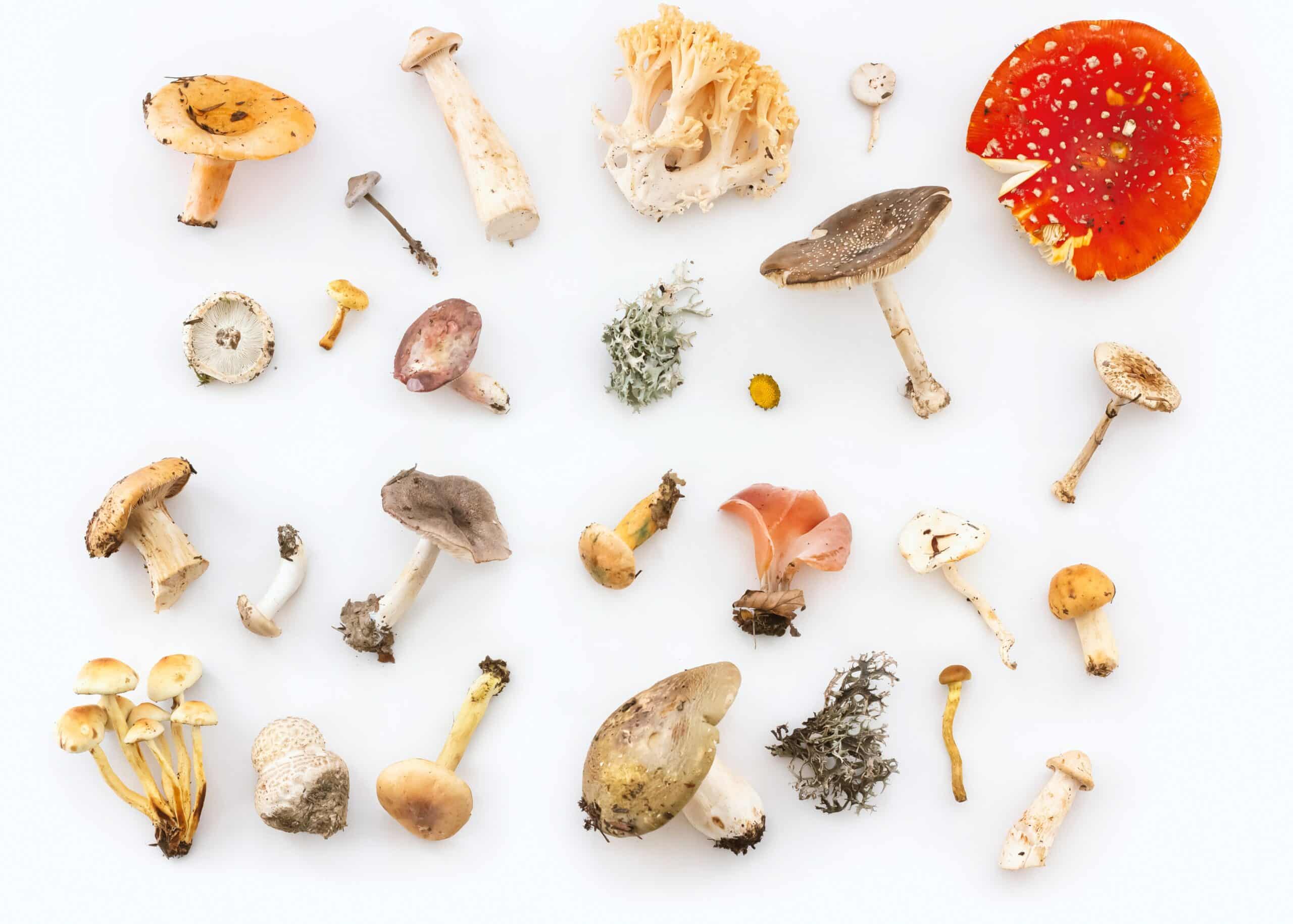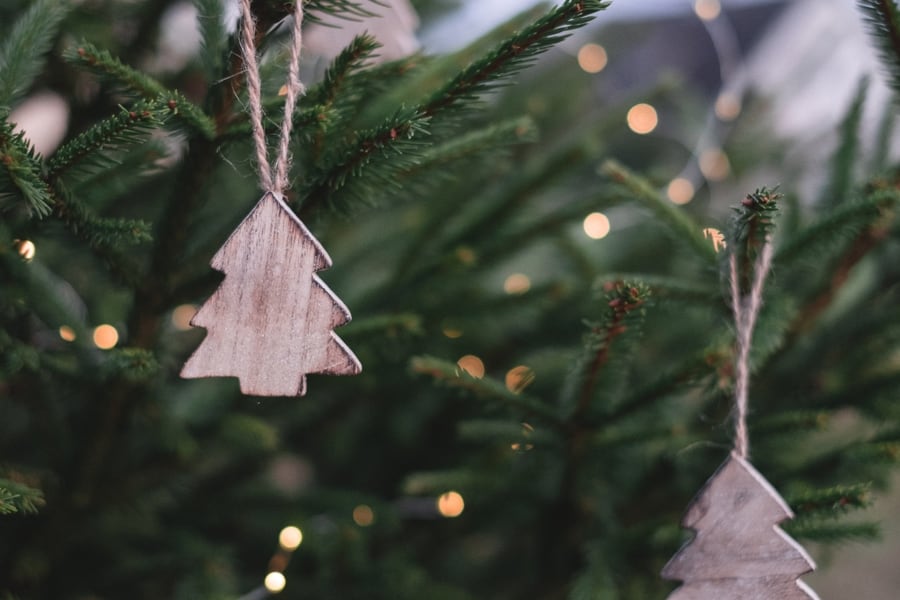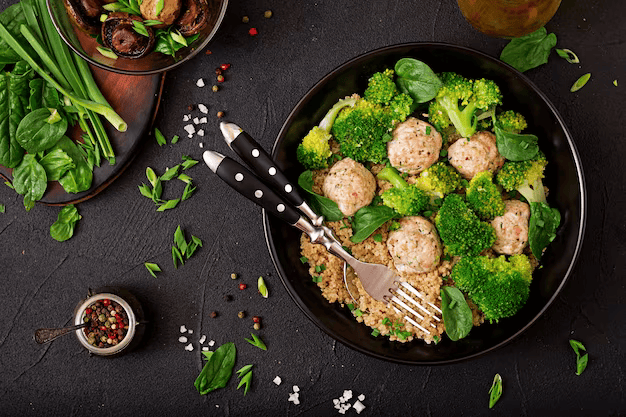Does the very sound of “edible mushrooms” take you on a psychedelic expedition to a kaleidoscope of vibrant colors and numerous shapes? If that is the case, trust me, you’re not alone out there!
In this article, learn about the 16 types of edible mushrooms that too with images. These delicious fungi can definitely enhance your cuisine.
The charm of the earthy, woody-flavored item speaks for itself with a long history that has a trail leading to some of the earliest civilizations. If we backpedal in time, we’ll find that the exoticism and aura of this humble item go back to the era of the ancient Romans and Chinese empires, where it was deemed as “God’s Food” and “Life’s Elixir,” respectively.
From their inexplicable sensory characteristics to their benevolent contribution to the culinary world, the stature of edible mushrooms has grown exorbitantly over time.

An essential item of gourmet cuisine across the oceans, this culinary wonder has made an impeccable mark on mankind. With more than 14,000 varieties present, several edible mushroom types have become a much sought-after item amongst people with different tastes.
But not all kinds of mushrooms can be eaten as some are poisonous and unhealthy properties, which can lead to various digestive issues. That being said, there also exist several edible mushroom types that are perfectly safe to consume, provided they get cooked properly.
So why not take a look at some of the healthy properties of these delectable items, followed by a listicle of best-tasting edible mushrooms?
Benefits of Mushrooms
Packed with essential elements and minerals, edible mushrooms are an excellent addition to one’s diet. Being a rich source of potassium, they help in reducing the tension in the blood vessels and lessen the bad impact of sodium in the body. Mushrooms are known to be a low-calorie source of antioxidants, fiber, and protein that can help mitigate serious health issues like cancer, heart disease, and diabetes, amongst others. They are also known to lift mood, boost memory, give energy, and help in the production of red blood cells.
Owning the title of being the only food that is blessed with Vitamin D, mushrooms indeed have a nutritional punch to them. Mentioned below is a comprehensive guide to the levels of vitamin D present in common edible mushroom varieties.

As such, if you wish to learn more about the various types of edible mushrooms, hop on with us on this sojourn, where we unravel the most loved edible mushroom variants you can relish.
So let’s get started right away!
Top Luscious Types of Edible Mushrooms
Given your palate is a sumptuous ride, these 16 classic mushrooms are surely going to add to your taste buds and ratchet up your occasion in no time.
As such, to your aid, we have added the edible mushroom name list and pictures, so that next time you visit the nearby store, you know which one to put in your grocery bags instantly!
1. White Button Mushrooms

One of the most common varieties of mushrooms, the White Button Mushroom is one of its kinds. A popular choice for cooking, they possess a mild flavor, a milky hue, and an extremely soft texture. This variety of mushroom can be eaten raw or cooked as per one’s taste and preferences.
Button variants go brilliantly well with Italian cuisines, along with soups and salads, and even Indian curries. Surprisingly, about ninety percent of the consumable mushrooms are from this variety!
White edible mushrooms have innumerable health benefits that are hard to overlook. Low in calories and sugar, they are blessed with a lot of protein since they are exposed to sunlight for a longer duration of time. They help keep the bones stronger by helping absorb calcium in the body.
Rich in vitamin B12, these mushrooms are an apt option for vegetarians at large. From aiding in improving gut bacteria and insulin resistance to causing a reduction in blood sugar levels, white mushrooms can make you go gaga with their health benefits.
Alternate Names: Button Champignon (de Paris), Able Mushrooms, Cultivated Mushrooms.
2. Portobello Mushrooms

Giant varieties of button mushrooms and Portobello mushrooms are native to North American Grasslands and Europe. With a woody flavor, these mushrooms are used extensively in cooking, making them one of the most consumed mushrooms across the globe. Possessing the title of being one of the best mushrooms to eat, they are highly impressive due to the exotic meaty texture that makes them a great meat substitute.
Portobello can grow up to ten inches but are usually harvested when small, around an inch big, and sold in dry form. Due to their dense properties, they are used in various cooking forms ranging from broiling and roasting to grilling.
Rich in copper and selenium, these mushrooms are also a natural source of vitamin D. Possessing Vitamin B6 or niacin, Portobello helps in the metabolism process by converting food into energy and synthesizing fatty acids in the body.
Alternate Names – Field Mushroom, Portobello, Open Cap Mushroom.
3. Shiitake Mushrooms

Renowned for their rich and savory taste, Shiitake Mushrooms have a Japanese origin. In their culture, Shiitake means “Oak Fungus”, which invariably points toward where these mushrooms can be found sitting in the wild. With a light, woodsy aroma, this common edible mushroom variant has a meaty texture, making them an ideal option that goes well with almost everything and anything.
This mushroom has a more flavorful property than most of the other mushroom variants. They are usually used in soups, simmered, steamed, and stir-fried cuisines.
Shiitake is known for its medicinal properties and is available in powdered form in various herbal outlets. High in fiber and Vitamin B, these mushrooms help boost the immune system efficiently. They also help lower calories, diabetes, and blood cholesterol levels amongst others. From combating the hardening of arteries to possessing antiviral and antibacterial properties, they are blessed with numerous benefits, making them one of the most popular mushrooms in the world.
Alternate Names: Black Forest, Black Winter, Brown Oak, Chinese Black, Oriental Black, Golden Oak, Donko.
4. Oyster Mushrooms

Amongst the different types of edible mushrooms, Oyster Mushrooms are one of the biggest, most common and versatile variants. These fan-shaped mushrooms have a delicate flavor, odor and a velvety texture. Extremely tender, they get used in sauces, soups, and stir-fried dishes. With a whiteish hue, Oyster mushrooms get their name from oysters because of their striking similarity.
Easy to cultivate, this variant is now a commercially grown item across the globe. Grown in tropical regions, these mushrooms can be found gracing many Chinese and Japanese dishes. A unique quality of Oyster mushrooms is that their aroma and flavor get enhanced when exposed to heat.
Blessed with numerous health benefits, these edible mushrooms are loaded with essential vitamins and minerals and are usually fat-free in nature. They help lower cholesterol; provide enhanced immune function and metabolic health along with boosting heart health.
Alternate Names: Angel’s Wings, Abalone Mushroom, Tree Oyster.
5. Cremini Mushrooms

Amongst the types of mushrooms to eat, Cremini Mushrooms are another most loved variant that can be used interchangeably with white button mushrooms. Also labeled as “Baby Bellas,” these mushrooms have a firm texture, dark color and a mind-boggling flavorful property. Cremini usually gets used in soups and stews as they can hold up in a better way when added to liquid.
These mushroom variants are also used in pasta, omelets, tacos, tarts, casseroles, and even risotto. One can use them in various cooking methods, such as sautéing, roasting, simmering, or baking. Low in calories and fat, Cremini mushrooms are a must-add to the diet chart.
Flowing with antioxidants, potassium, and fiber are extremely good for boosting heart health. From reducing inflammation to offering high levels of Vitamin B, this mushroom variety is a truckload of surprising health boons that are enough to make them on the priority list for people around the globe.
Alternate Names: Golden Italian Mushrooms, Brown Mushrooms, Roman Classic Brown, Italian Brown.
6. Enoki Mushrooms

Amongst the edible mushrooms, the Enoki Mushroom is a rare variant that has a shiny white cap attached to its stem, giving it a peculiar yet enticing look. With a mild and fruity flavor, they are used extensively in East Asian cuisines. Enoki can be found in sandwiches, soups, salads, and pasta sauces amongst others. Given their two different varieties, wild and cultivated namely, these mushrooms make a good addition to many cuisines across the globe.
The best part about Enoki mushroom is that it can either be eaten raw or cooked per one’s preference. However, one must be careful not to overcook them as it leads to the tightening of these mushrooms, making their taste unpleasant.
Rich in Vitamin B1, B2, B3, and B5, the Enoki mushrooms are truly blessed with essential properties that are good for health. These mushrooms also contain iron, calcium, copper, selenium, and phosphorus needed by the body. They are loaded with dietary fiber and amino acids, which help increase metabolism, reduce fat, and improve the immune system. They assist the body in fighting off allergies, while also improving one’s digestion process.
Alternate Names: Enokitake, Winter Fungus, Winter Mushrooms, Futu.
7. Shimeji Mushrooms

Native to Eastern Asia, Shimeji Mushrooms can be found in clusters and have chunky stems and tops. Amongst the edible mushroom types known, this variant possesses a speckled brown cap with a white base. Shimeji usually tastes bitter when eaten raw but develops a crunchy, sweet-nutty flavor once cooked. One can use these mushrooms in stews, soups, sauces, and even stir-fried food items.
Shimeji variants taste heavenly when used alongside noodles. One can get it sautéed whole, including its delectable stem! These variants are blessed with umami-tasting compounds (the essence of deliciousness) since they contain glutamic, aspartic, and guanylic acids.
Low in fat and high in dietary fiber, Shimeji are also a good source of Vitamin B, copper, zinc, and even protein. They help in weight loss and aid in managing diabetes. These mushrooms also contain antimicrobial and anti-inflammatory properties, beneficial for the body.
Alternate Names: Beech Brown Mushroom, Buna Shimeji, Clamshell Mushroom.
8. Porcini Mushrooms

Among the types of edible mushrooms to eat, Porcini Mushrooms are used extensively in Italian cuisines. Blessed with a woodsy flavor and smooth texture, this variant is large and can grow up to twelve inches when measured in diameter. One of the best gourmet mushrooms, porcini has a thick stem that is somewhat sticky.
These mushrooms can be used in broth, eggs, meat items, sauces, pasta, and numerous vegetarian dishes of your liking. It is usually difficult to grab fresh Porcini mushrooms, so if you do, snatch them up in the blink of an eye!
These mushrooms have several nutritional benefits that can help in staying healthy and fit. Porcini contains antioxidants that aid in boosting immunity and are also loaded with proteins that are essential for muscle mass. They are devoid of trans fat, cholesterol, or saturated fat.
Alternate Names: King Bolete, Steinpilz, Polish Mushroom, Borowik, Penny Bun.
9. Paddy Straw Mushrooms

A popular variant of button mushrooms, Paddy Straw Mushrooms are one of the most common edible mushrooms present on earth. Blessed with rich flavor and aroma, this item is cultivated throughout East and Southeast Asia.
One of the easiest mushrooms to cultivate, these are extremely popular variant that is loved and liked by people across the world. Used extensively in Asian cuisines, these mushrooms can be found dried or canned. They are also freshly available in the areas where they get cultivated.
Paddy straw mushrooms hold a significant amount of health benefits. Loaded with fiber, protein, iron, and vitamin B, these mushrooms prove to be extremely nutritious. They help boost the immune system and assist in lowering cholesterol. Paddy’s contains vitamin D, which strengthens bone and beta-glucan which prevents cancerous cell growth. These mushrooms also help fight anemia.
Alternate Names: Straw Mushrooms, Chinese Mushrooms
10. Maitake Mushrooms

Amongst the various types of edible mushrooms, Maitake can be recognized from afar as it resembles the tail feathers of a hen. In Japanese, Maitake means dancing mushroom and can be found in the wild parts of Japan, China, and North America.
These mushrooms possess an earthy aroma and a delicate texture that is hard to resist. Maitake gets used in multiple dishes including burgers and stir-fried items. It can be sautéed in oil or butter and cooked to one’s liking. Blessed with a succulent taste, Maitake’s can be great for occasions that call for mushrooms.
These mushrooms are a storehouse with immense health benefits contained inside. From helping lower blood sugar levels and killing cancerous cells to boosting immune function, Maitake has a lot to offer. Not only this, but they also promote fertility and help reduce blood pressure and cholesterol levels.
Alternate Names: Hen-of-the-woods, Grifola, Shelf Fungi
11. Morel Mushrooms

Amongst the edible mushroom types, morels are the most elusive mushrooms present on earth. These decadent ingredients are usually found making their way straight to plush restaurants and cuisines, adding a rich flavor and texture to them. Since they are hard to cultivate, have a short growing season, and are perishable, they are highly expensive in nature.
Morels come in all sizes and shapes. They can have an oblong to bulbous appearance and a unique color from blond to gray. They can be recognized easily as their exterior resembles that of a honeycomb. They are one of those edible mushrooms near Portland city, Oregon, US, that have a huge fan base in the country and abroad.
Apart from their classic tastes, these mushrooms also have several health benefits. Blessed with iron, phosphorus, zinc, vitamin D, folate, and riboflavin, they have a high nutritional quotient. Morels are also rich in antioxidants, fiber, and protein and low in calories.
Alternate Names: Sponge Mushroom, True Morel.
12. Chanterelle Mushrooms

Found in small groups, Chanterelle mushrooms are some of the most beloved and celebrated edible mushrooms across the globe. With a delicate flavor, they are usually mild and peppery in essence, which makes them every chef’s go-to item. A well-known variant, they have a classy and exotic taste that is hard to resist.
Ranging from yellow to deep orange in color, Chanterelles can be easily identified in summer. Apart from this, their most distinctive property is their false gills which appear wrinkly with a different color from the rest of their body.
These mushrooms are versatile and loaded with health benefits. Rich in fiber, vitamin D and B, Chanterelles are also a good source of antioxidants required by the body. A nutrient-dense variant, they are a good inclusion in an everyday diet with a positive health impact in the long run. They also work wonders in certain eye conditions and help improve vision.
Alternate Names: Golden Chanterelle, Girolle.
13. Lion’s Mane Mushroom

A culinary gem, Lion’s Mane mushrooms are one of the best tasting edible mushrooms. White and shaggy, they have distinctive characteristics that are hard to overlook. They are eaten casually or can be consumed as a supplement per one’s need. Serving culinary needs, this unique variant possesses a mildly sweet flavor and a soft texture similar to a shellfish.
Often described as seafood-like in taste, Lion’s Mane can make any dish special with its humble presence. With earthy overtones, the mushrooms get used along with soups, broths, and sauces.
These mushrooms contain compounds that help stimulate brain cell growth and protect them against diseases like Alzheimer’s. They help boost the immune system, reduce anxiety and depression, and promote heart health along with controlling blood sugar levels.
Alternate Names: Mountain-Priest Mushroom, Bearded Tooth Fungus.
14. Giant Puffball Mushrooms

In the edible mushroom list, Giant Puffball mushrooms are a wonder in themselves. Mostly rounded, these mushrooms can be found in different shapes and sizes. They do not possess gills, caps, or stems, and look like a golf ball or a volleyball in its entirety. Usually found in meadows, they can also be found in lawns or grass, which accentuate their ball-like appearance.
Puffballs are usually sautéed or dried and even powdered to be used in soups. These mushrooms have a long history and are considered to be food items for indigenous people. They are one of those varieties of edible mushrooms near Washington DC that are overtly unique in their essence.
Giant puffballs are known to have active ingredients and immense antioxidant properties required by the body. They help in the prevention of oxidative damage and several other illnesses. These mushrooms are also loaded with antiviral and antibacterial properties that help protect against various infections.
Alternate Names: Wolf Farts
15. Black Trumpet Mushroom

Among the different types of edible mushrooms, Black Trumpet Mushrooms are one of the most loved variants in the world. Growing in hardwood forests, they can usually be found near trees with broad leaves such as oak or beech. These mushrooms grow in North America, Europe, and Asia.
Black Trumpets have a soft texture, and they feel like suede material owing to their soft surface. With a rich, smoky, and fruity aroma, their presence in cuisines cannot be overlooked. However, it is ideal not to use much of these mushrooms in a dish as they might cause a bitter taste if overused.
High in Vitamin B12, these mushrooms, like their counterparts, are full of nutrients. A good source of vitamin C and antioxidants, they help keep the body healthy and fit, away from diseases. These superfoods also aid in weight loss and help lower cholesterol.
Alternate Names: Horn of Plenty, Trumpet of the Dead.
16. Hedgehog Mushrooms

Hedgehog mushrooms are one of those edible mushroom types that are pleasantly surprising to behold. With their yellow to orange caps, they are reminiscent of summer vibes that add to their beauty. With fork-ridges on their underside, these mushrooms possess an attractive appearance that garners attention instantly.
With an earthy, nutty, and sweet taste, these mushrooms have a bit of peppery aftertaste that makes them one of the most delicious edible fungi across the globe. They have a crunchy texture and firm flesh.
Hedgehog mushrooms are low in fat but high in protein. They possess antimicrobial properties that are essential elements for a healthy body. They are a good source of copper, protein, vitamin B, zinc, and selenium. They also help strengthen bones and regulate blood clotting amongst others.
Alternate Names: Sweet Tooth, Wood Hedgehog.
Apart from this edible mushroom list, you can go on eyeing other variants too, but for now, give a shot to these mushrooms that will surely add up to your palate’s experience.
Poisonous Mushrooms to Avoid
Since many of the mushroom species have their doppelgangers, one must be aware of the ones that may have a poisonous element to them. As such, let us have a look at some of the most dangerous mushrooms to avoid:-
1. Death Cap
One of the most deadly mushrooms, Death Cap is a must to avoid. These are found worldwide, where half of this single mushroom is enough to kill an adult.
2. Destroying Angel
Having a striking similarity to many edible mushrooms, Destroying Angel can cause kidney and liver failure within a few hours or days of its consumption.
3. Lepidella
Mostly found in Asia and Japan, this poisonous mushroom can lead to kidney and liver failure although they are not as deadly as Destroying Angel or Death Cap.
4. Fool’s Mushroom
Carrying a white appearance, Fool’s mushrooms are another deceptive species that must be avoided. Although they usually grow in Europe, they can also be found in woodland settings.
5. False Champignon
False Champignon, though not deadly, is still poisonous. They can cause gastrointestinal issues if consumed.
Tips for Selecting Mushrooms
As you go on the quest to find the best mushrooms on the market, make sure they feel firm and possess a consistent color. Dark spots and inconsistent colors indicate that your prized good has been sitting on the shelves for quite too long. The surface should ideally be dry but not entirely dry up.
Tips for Storing Mushrooms
The different types of edible mushrooms contain high moisture and hence, they are intrinsically perishable. Therefore, it is recommended to store them in a container with sufficient airflow. You can also wrap mushrooms with any of the paper towels and keep them in an open paper bag.
Tips for Cleaning Mushrooms
To clean a mushroom, begin by wiping it with a clean towel to dust off the dirt. Remove the stem and completely peel the outer layer until the white cap is visible. Wash the mushrooms and cut them into small pieces to get started.
Frequently Asked Questions (FAQs)
What are edible mushrooms?
Edible mushrooms are those species of micro fungi that are devoid of poisonous elements and have a desirable taste and captivating aroma. These mushrooms can be found growing above or below the ground from where they can be hand-picked.
Are mushrooms healthy?
Yes, mushrooms are extremely healthy for the body. Blessed with various micronutrients, they boost and support a healthy immune system, preventing cell damage in the long run.
Which edible mushroom possesses the maximum protein?
White mushrooms contain the maximum percentage of protein, while oyster mushrooms carry the most protein on a per-weight basis.
Which of the mushroom types tastes the best?
Although all the consumable mushrooms have a unique taste of their own, White button mushrooms are one of the most popular variants loved by different nationalities
Can mushrooms be eaten every day?
Yes. Mushrooms are a great addition to everyday diet since they are loaded with healthy nutrients required for the smooth functioning of the body.
What is the ideal and healthiest method to cook edible mushrooms?
The best way to cook mushrooms is to go for a grill or microwave method. This is because boiling or frying leads to a reduction in their antioxidant properties.
Is it a good idea to soak mushrooms before cooking?
No, mushrooms should not be soaked before cooking. This is because they have a tendency to absorb water, and hence they will not get brown nicely if they are laden with water.
Should mushrooms be kept in the refrigerator?
Yes, it is ideal to store mushrooms in the fridge because of their high water content so as to keep them as fresh as possible.
Can the stem of mushrooms be eaten?
Although many people only eat caps, it is equally good to consume stems since they too have the same nutrient value and flavor as any other part of the mushroom.
Is it necessary to peel mushrooms?
No, avoid peeling mushrooms as a lot of flavor lies in their skin. Instead, use a damp cloth to wipe off the dirt and mud from the outer layer.
How many edible mushrooms are there in the world?
There exist over 2000 varieties of edible mushrooms in the world.
What are the top 5 edible mushrooms across countries?
Though there are different varieties of mushrooms available, the top 5 include White button mushrooms, Portobello, Shiitake, Oyster Mushroom and Cremini Mushrooms.
Just a Head’s Up- Those with autoimmune diseases such as lupus, arthritis, asthma, etc., should avoid consuming mushrooms.
You may also like: Types of vegans
Takeaway (The Closure)
From dependable Porcini to the very meaty Shiitake, mushrooms have a lot to offer and are indeed one of the most intriguing creations of nature. With the given mushroom types pictures along with their properties, one can easily make out the lusciousness and the subtle intricacies of these much-loved items.
We told you about our hearts doting over some of these types of edible mushrooms amongst others! Who are you crushing on?
Looking for a healthy vegan meat substitute? Check out this article.
Do let us know in the comments section below!






This information is really very helpful
I got a mushroom growing in my yard and I don’t know what it is